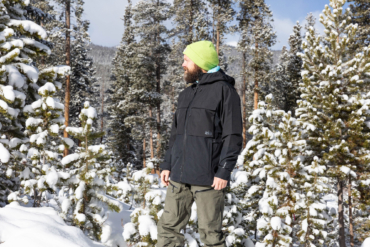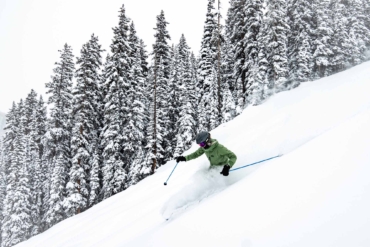The North Face Summit Series uses a bevy of technologies that emphasize breathability and warmth during heart-pumping efforts. Used together, they could change your winter layering strategy.
Cold-weather aerobic pursuits test the limits of gear designed to keep you warm and dry. The North Face Summit Series has new apparel with new approaches to overcoming those limits for a more comfortable year in the wild.
Below is an overview of traditional layering philosophy and how recent innovations have shaken up that norm. Then, we go over key apparel pieces from The North Face Summit Series that showcase the brand’s latest tech and see how they can work as a layering system for cold-weather use.
Explore The North Face Summit Series
How to Layer for Winter
The conventional wisdom for winter layering is to create an apparel kit or system. Every piece works together to keep the wearer comfortable across a wide range of temperatures, as well as dry with changing weather conditions.
Proper layering will provide what you need for the most inclement weather, and pare down appropriately as you need — say, as your core temp rises with high-output activity. For example, skinning up, you’ll be making much of your own warmth, so you can stick with a base layer and keep other layers packed. But once you’ve reached the summit and cooled off a bit, you’ll want to add a wind-protective shell — and maybe an insulating midlayer for the chilly descent.
Choosing your cold-weather layers will take time to learn if you’re new to them.
The weather forecast is an important first step, but only one factor. Conditions on a mountain ascent can take you from shady wooded areas to long bouts of exposure to sun and wind. You need to dress for all of those conditions — and then some.
Beyond the weather, you should have an idea of how an activity will tax your body. Do you typically run hot or cold? Do you sweat a lot? Will this be a casual trail hike through the woods or a hands-on-knees lung-buster at altitude?
Besides comfort, carrying the right layers also means being prepared for conditions changing for the worse or an emergency. If things go sideways on a backcountry adventure, having the right layer can help you ride out a storm or mild injury while waiting for rescue.
Layer-by-Layer Basics
Understanding the basics of layering is a key component in staying comfortable — and safe — during winter adventures. In short, you wear three layers to stay dry and warm, and each serves a different function. We go over some layering examples later on, but here are the key points to understand.
Base Layers
Also called “next-to-skin layers,” these close-fitting garments retain some body heat while wicking away sweat. Active users should prioritize wicking and let the midlayers do most of the insulating.
Staying dry is of primary importance when choosing layers. If sweat starts pooling, your body will start cooling, which works against the insulating layers. Your base layer will provide a nominal measure of insulation, but the right layer can do wonders for moisture management, which is the bedrock of the entire layering system.
Pro tip: Utilize quarter- or full-zip base layers to dump heat during max aerobic efforts.
Midlayers
Insulation layers can emphasize breathability (active insulation) or warmth (static insulation). This category has the widest range of options.
Lighter insulation, like a grid fleece, traps warmth while allowing body heat (and moisture) to escape through the channels of the grid. Down or synthetic insulation stuffed into baffles will trap body heat for greater warmth.
The development of active insulation midlayers has shaken up this category in recent years. Jackets built with exposed insulation can make them lighter and breathable for use in high-output activities. And they include a light, breathable shell fabric to protect against light rain or snow. Such jackets allow the user to enjoy a greater range of temperatures before they need to dump heat or add another layer.
For hikes and moderate skiing in dry conditions, you may choose to wear a breathable, active midlayer with moderate insulation, and stash a wind or rain shell in a pocket. For slower efforts at altitudes that will lead to exposure and downtime, consider a similar setup for the way up and a heavy down puffy with wind and weather repellency for maximum warmth.
Outer Layers
Shell layers protect from the elements (and keep insulating layers dry). A softshell wind layer in the summer won’t protect against the rain but will allow perspiration to escape. A waterproof hardshell comes with varied breathability performance for use in rain, snow, and windy conditions.
If you’ve combined more modern layers with older ones, you may have found yourself limited by outdated apparel. Wearing a new, more technical base layer that wicks moisture away from your body into a not-so-breathable puffy will likely leave the jacket soaked in no time — and have you cooling off soon thereafter.
Instead, an outer layer imbued with the latest in materials science will perform across a greater range of temperatures. And it can help you adapt to the changing climate without the necessity of changing layers.
As long as it’s wicking and warming, you get a little more wiggle room when it’s time to stop and dump heat or layer up.
The North Face Summit Series: Built for Layering

Designed as a layering system, the Summit Series manages heat, moisture, and modularity during high-output activities. The North Face made this collection with big-mountain efforts in mind and packed in its new performance innovations to add warmth and drop weight. Those benefits are now tuned for each specific activity with features to enhance your climb or snowsport, according to TNF.
The brand designed its Summit Series with a modular approach, making base layers and midlayers for all activities. Now, the collection’s outer layers are “tuned for activity” with specific features. This efficiency can save space in a multisport athlete’s closet.
To further build out the collection, it now includes footwear, from fully rigid double boots to scrambling shoes built for technical approaches. The same Summit Series tech also trickles down to accessories and equipment like gloves, backpacks, sleeping bags, tents, and more.
The Summit Series is what athletes like Kit Deslauriers wore as she completed her quest to become the first to ski the world’s highest Seven Summits. Jimmy Chin, Conrad Anker, Alex Honnold, and the rest of the Queen Maud Land expedition team also brought Summit Series with them to Antarctica.
And GearJunkie editors came away impressed after testing the Summit Series Advanced Mountain Kit, saying that “when the gear is right, you forget it exists.” The Advanced Mountain Kit technology can now be found in the new Summit Series line.

Summit Series: Learn the Layers
A good cold-weather kit should keep you dry from the weather on the outside, but also dry on the inside by allowing perspiration to escape. There are a few different kit combinations to achieve this depending on the intended activity.
To help navigate the Summit Series apparel, the brand is changing up the names of its layers. Midlayers are named after routes and subpeaks (Casaval, a ridge on Mt. Shasta), while outer layers are named after peaks and mountains specifically relevant to the intended activity (i.e. Pumori).
The North Face Base Layers

Summit Series Pro base layers prioritize moving moisture from the body. High-output adventurers may choose a DotKnit base layer under a midlayer, or use a heavier FUTUREFLEECE layer next to skin in colder conditions. For lower-output activities in the cold, DotKnit and FUTUREFLEECE can be paired for a mix of moisture-wicking warmth.
DotKnit: Dotknit comes in two weights — 120 for less-frigid adventures and 200 for the coldest days on the mountain.
These base layers emphasize moving sweat away from the body and drying faster. The DotKnit construction uses hydrophibic (next to skin) and hydrophilic yarns (face side) to actively pull moisture through the engineered ports in the fabric according to TNF.
The North Face says this unique base layer tech outperforms those using solely traditional synthetics or wool. Those materials aim to trap and pull moisture into the garment, rather than disperse it, for faster drying. When a base layer holds moisture, it can be uncomfortable and increase the risk of hypothermia if the aerobic output is not maintained.
The North Face Midlayers

The brand offers midlayers to meet different user preferences and more dynamic levels of exertion. The right midlayer (or lack thereof) lets users determine the range of warmth they want.
FUTUREFLEECE: This is available in two weights, FUTUREFLEECE and FUTUREFLEECE LT, with LT being lighter. It’s TNF’s take on a standard grid fleece, with octa-yarns, which have hollow sections to hold warmth. The lighter garment also uses a full-loop construction for a softer feel against the skin.
The North Face recommends FUTUREFLEECE as a heavyweight base layer or a light midlayer for use with a lighter jacket.
Ventrix: This tech debuted in 2017 and continues in several cold-weather jackets for its ability to work with a wide range of temperatures and move with the user in motion. The outer shell fabric and liner aim for breathability to prevent becoming a barrier to moisture released by the unique “vented” stretch insulation.
When a Ventrix jacket is flexed from walking or skiing, the vertical and horizontal openings in the stretch insulation open wider and vent moisture faster.
The North Face Outer Layers

Cloud Down: This provides more warmth with less bulk. The North Face uses a new “discontinuous baffle” construction with 800-fill ProDown that results in a greater down fill weight from less material. The brand says the new garments will weigh 20% less while also adding roughly 20% in down weight.
FUTURELIGHT: The brand’s most advanced waterproof-breathable technology emphasizes venting and breathability while on the move. An active midlayer beneath it should be the main insulator.
50/50 Down: This down insulation is constructed to be breathable during aerobic use. Each down-filled baffle is sewn individually to a breathable face fabric as well as spaced out to allow room between them.
The idea is that when the wearer flexes, the baffles are compressed closer together yet allow airflow in between. The North Face also designed 50/50 Down to prevent the down from shifting or leaking out and avoid the use of down-proof materials that then block the insulation’s breathability.
The outer jackets are less nuanced but differ in the range of insulation and expected output. The Pumori Down Parka prioritizes warmth over weight savings during slower, colder activities, or can be thrown on while taking breaks, belaying, or transitioning.
The Breithorn 50/50 Down Hoodie and Casaval Hybrid jackets both work for high-output use but allow the user to choose between down or synthetic insulation for their activities.
Now, let’s get into a few mission-specific examples of how Summit Series layers can be worn as a system.
Sport-Specific Layering
Mountaineering

Base: The Pro Tights and Crew layers use DotKnit, which leverages double-knit yarns and holes in its face fabric to create space for moisture to move away from the body. The construction has raglan sleeves, underarm gussets for mobility, and minimized seams with overlocked stitching for reinforcement.
Mid: The FUTUREFLEECE Full-Zip Hoodie is a slim-fit, full-zip hoodie using the brand’s FUTUREFLEECE fabric for a lighter and warmer midlayer. The fleece interior uses full-loop construction with yarns that the brand claims retain heat. The idea is to get the most warmth from the least material.
The shoulders are seamless to avoid stacking seams through layers and chafing under a backpack. Lastly, a concealed-zip chest pocket holds an internal pouch.
Outer: The Pumori FUTURELIGHT Bibs and Jacket are waterproof, windproof shells that emphasize breathability. The fabric is soft, so your ascents shouldn’t be tainted by a series of swishing sounds. High-wear spots are reinforced with Spectra ripstop, and both pieces have an articulated fit for mobility.
For mountaineering, the Chamlang FUTURELIGHT Jacket and Pants shells include harness-compatible hand pockets and underarm vents with AquaGuard zips and softer touches like a brushed-tricot chin guard and collar lining. The pants are reinforced in areas prone to wear.
The Chamlang kit is also the most pared down feature set in the Summit Series and is an option for climbers who still want the most technical equipment available with less fuss.
To top it all off, the Pumori Down Parka is stuffed with 800-fill ProDown in the offset Cloud Down baffle construction for warmth without all the bulk. Both hood and hem can be adjusted to keep air out. This is a big insulating layer that mountaineers will likely wear only during rest breaks or belaying.
Alpine Climbing

Base: With sedentary time likely, climbers may prefer to use the heavier FUTUREFLEECE Full-Zip Hoodie next to the skin to keep their core warm.
Mid: Depending on conditions, alpine climbers with a heavier base layer may choose to wear just the waterproof-breathable Torre Egger FUTURELIGHT Jacket as a light, protective shell during climbs.
Outer: For alpine climbing, the Torre Egger FUTURELIGHT Jacket is a waterproof, windproof shell that emphasizes breathability. It has underarm gussets made from lighter-weight fabric for breathability. A women’s-specific fit is also available.
The targeted use of YKK AquaGuard FlatKnit zips is used to slim its profile and allow flexibility. Likewise, the Torre Egger FUTURELIGHT Pant protects its three-layer FUTURELIGHT shell fabric with high-denier kick patches and internal cuffs to resist abrasion and puncture. These pants also include a narrower leg opening to accommodate alpine boots.
Charging summits or off the ice wall, athletes can throw on the Pumori Down Parka to stay warm at high altitudes.
Snowsports

Base: Again, the Pro Tights and Crew layers with DotKnit come in 120 and 200 weights for warmth with an emphasis on wicking.
Mid: Skiers and riders can reach for another layer of wicking insulation without the bulk. That’s where the FUTUREFLEECE Hoodie comes in. The fleece’s full-loop construction and octa-yarns offer a high warmth-to-weight ratio, according to the brand.
Outer: For Big Mountain (backcountry or sidecountry), heavy weather conditions, and freestyle, The North Face built the Verbier Kit. The Verbier FUTURELIGHT Jacket sports a drop-tail hem with an internal cord-lock adjustment and two big chest pockets with AquaGuard zips and internal gear loops.
The Verbier FUTURELIGHT Bib uses a hybrid suspender construction with inner tab mounts for using the drop-seat while the suspenders are still attached. Targeted areas include a stretch-woven upper bib and back panel for movement and breathability. Lastly, there are inner-leg vents with water-resistant zips.
Backcountry/Sidecountry riders or high aerobic activity athletes can reach for the Stimson FUTURELIGHT Jacket for its articulated shape, four-way stretch, and mini powder skirt system. It also has two internal mesh drop pockets for skins or goggles.
Likewise, the Summit Stimson FUTURELIGHT Pant is reinforced with Spectra ripstop in the knees along with kick patches. The left thigh pocket stashes things behind a YKK AquaGuard zipper and internal gear loop. The women’s-specific style includes a higher rise to rest on the waist.
Summit for Yourself
Even if you’re not heading to the windiest or snowiest heights this winter, these layers can allow greater flexibility in how you fend off the cold. Even modest efforts will crank out sweat that needs to escape — ideally without you losing body heat.
Start with one layer. See if it does more to keep you dry and warm, and then you can dial the rest of your layering system. From there, you might want to pick up more Summit Series layers for the full effect.
Spending a little bit more on a jacket that can perform during a wider range of activities is still more affordable than a separate jacket for each occasion. (And it takes up less closet space.)
Explore The North Face Summit Series
This article is sponsored by The North Face. Find out more about the Summit Series online.







